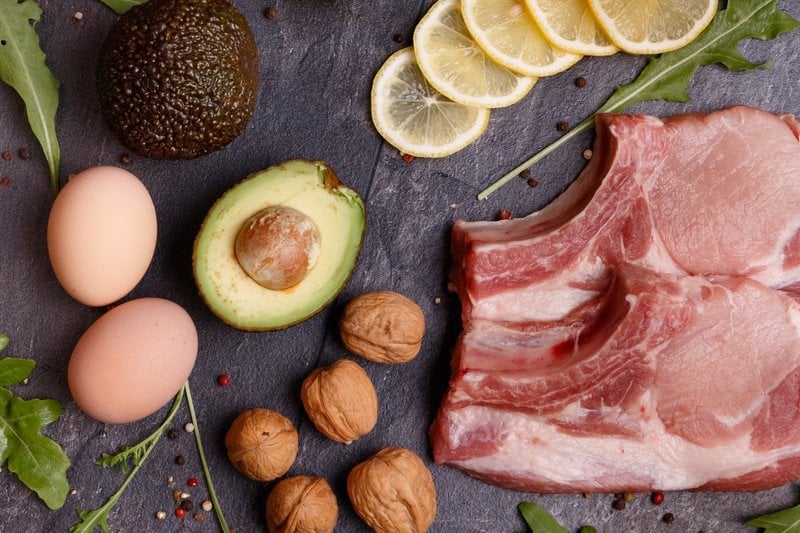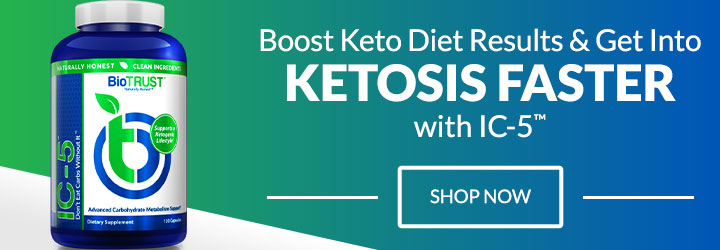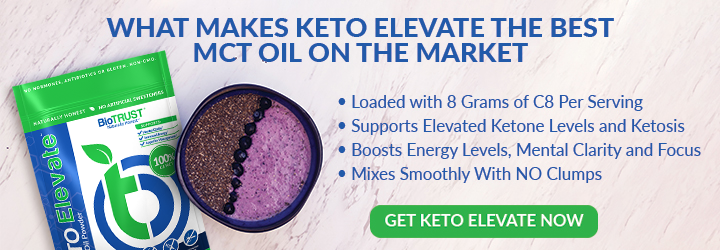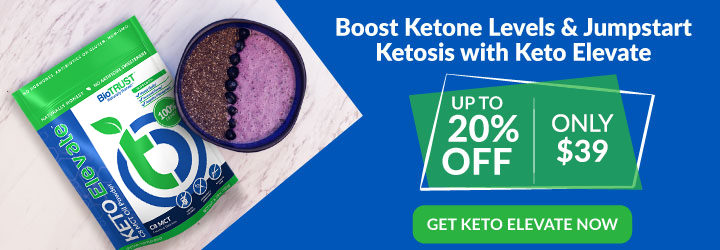Dirty Keto vs. Clean Keto: What is the Difference?

The keto diet, keto foods, keto weight loss, keto flu, keto controversy… keto, and everything that surrounds it, is one of the biggest ideologies to hit fitness and health communities in decades. It’s claimed to be an easy, powerful tool for weight loss. It’s been touted for crushing cravings, providing endless energy, creating sharper thinking, and so much more… Yet, with its highly restrictive nature, it can be terribly difficult for many to follow. Enter “dirty keto.” What is dirty keto? And how do dirty keto vs. clean keto compare?
What Is the Keto Diet?
As Coach Tim so clearly explained, “The ketogenic diet is a very-low-carbohydrate, high-fat, moderate-protein dietary approach. It’s more commonly referred to as a very-low-carbohydrate ketogenic diet (VLCKD). Or ‘keto’ for short.”
Although interest in the keto diet has exploded in the past few years, the diet itself is not new. It actually dates back to 1924 when Dr. Russell Wilder created it to help in the treatment of epilepsy. (And it’s still used successfully in that regard today. Indeed, some people have been able to get off medication by following the diet closely. 1)
Today, the majority of folks who follow the keto diet do so for weight management as well as to help manage blood sugar levels (such as with type 2 diabetes). Yet the ketogenic diet has long been promoted for its therapeutic potential for health conditions, especially those relating to neurological disorders (like Alzheimer’s, traumatic brain injury, and autism) as well as select cancers and other diseases.
For more on the history and science behind the ketogenic diet, I highly recommend Coach Tim’s Beginner’s Guide to Keto.
Dirty Keto vs. Clean Keto
Whether you’re following clean or dirty keto, you’ll be consuming a very low-carb, high-fat diet. That is, you’ll eat no more than 5% of your daily calories from carbs (usually less than 20 – 30 grams per day) with a low to moderate intake of protein (just 15 to 20% of calories). That means the majority of your daily calories—70 to 75%—come from dietary fat. 2
The difference between dirty keto vs. clean keto is that clean keto focuses on whole, nutrient-dense foods. The focus is on quality whole foods like grass-fed beef, free-range eggs, wild-caught seafood, healthy fats like MCT, fish, coconut, and olive oils, and some non-starchy vegetables like sprouting broccoli, spinach, kale, asparagus, Brussels sprouts, cauliflower, and zucchini.
On both dirty keto vs. clean keto, high-carb foods like grains, tubers, breads, and pastas—as well as most fruits—are off the menu.
On clean keto, the consumption of any processed foods is minimized. Dirty keto, which is sometimes called lazy keto, on the other hand, isn’t so rigid. Yes, the diet is still high in fat and very low in carbohydrates. However, when it comes to what you eat, there’s less emphasis on food quality.
Instead, dirty keto focuses only on the macronutrient ratio with less concern for where those macronutrients come from. So, it can be more appealing to folks juggling a busy schedule.
In other words, dirty keto allows you to eat more packaged and processed foods. After all, following the standard keto diet can take a lot of time to plan, prepare, and cook your clean keto foods.
- Dirty keto can be followed by hitting a fast-food joint for a double bacon cheeseburger without the bun, for example.
- The clean keto dieter would instead stay at home to prepare a grass-fed steak in organic butter with a side of spinach salad topped with bacon, mushrooms, and onions.
Someone following dirty keto vs. clean keto may pick up some salami and cheese to snack on a road trip. The clean keto diet might, on the other hand, ensure they have some homemade fat bombs in their cooler before hitting the road instead.
The benefit of following dirty or lazy keto is that it’s far easier and more convenient to follow, especially long term. Your options are a lot wider, and you can even find foods at the local convenience store or fast-food joint to fit your macros.
For example, some foods someone following a dirty keto diet might eat that a clean keto eater would avoid include:
- Artificial sweeteners, including sucralose and aspartame
- Processed oils like sunflower, safflower, corn, cottonseed, soybean, and canola oil
- Processed proteins
- Low-carb snack foods like store-bought cheese chips or low-carb chips or cookies
- Pork rinds and beef jerky
- Chocolate
- Salami and cheese
Dirty keto can also include “cheat” or free days, which involve consuming more carbs, including, for example, baked goods or processed chips or pretzels. 3
The Health Downsides of Dirty Keto
Unfortunately, highly processed foods can come with a number of additives as well as excess sodium. While salt isn’t necessarily the devil it’s been made out to be, processed foods often provide excessive amounts (in particular, relative to potassium), which could increase blood pressure as well as the risk for heart disease, stroke, and kidney disease, especially for people who are sensitive to salt. 4, 5
In addition, ultra-processed food intake is associated with the increased risk of cardiovascular, coronary heart, and cerebrovascular diseases, along with weight gain, diabetes, and overall mortality. This is why nutrition authorities in all sectors recommend consuming more unprocessed or minimally processed foods. 6, 7
Ultra-processed foods are also likely to contain more hidden sugars, which is detrimental to getting into and staying in ketosis. And they are also likely to contain hidden additives like MSG (monosodium glutamate), which has been linked to increased risk for becoming overweight or obese, metabolic syndrome, type 2 diabetes, and even cancer. 8, 9
Because you are allowing yourself to eat more processed foods, you may also find yourself lacking in vital vitamins and minerals, such as vitamins B12, C, D, E, and K as well as copper, magnesium, zinc, and others. 10
Clean keto eaters are also more likely to eat a variety of quality non-starchy vegetables, including asparagus, broccoli, kale, and spinach. Dirty keto eaters may get few if any vegetables at all.
Other Types of Ketogenic Diets
You may have noticed that the people around you who follow the ketogenic diet have different guidelines or adjustments they’ve made to the diet. In other words, it goes beyond dirty keto vs. clean keto. In addition to the standard (or clean) ketogenic diet, there’s also:
- Cyclical ketogenic diet (CKD), which has cycles of higher carbohydrate consumption between ketogenic cycles. For example, follow the clean keto diet Monday through Friday (for five days) and then allow two higher carbohydrate days over the weekend (for two days). And then repeat.
- Targeted ketogenic diet (TKD), which allows you to eat additional carbs after intense exercise.
- High-protein ketogenic diet (HPDK), which provides more protein (at around 35%) and a bit less fat (60%) with a mere 5% of calories as carbs. 2
- Classic keto, which provides just 6% protein, 4% carbohydrates, and 90% fat.
- MAD keto (or modified Atkins diet), which has no restrictions on protein, calories, or fluids, and doesn’t require foods to be weighed or measured. Rather, it focuses on carbohydrate counts (staying under 15 to 20 grams per day), allows more food freedom, and encourages plenty of fluids, including Fruit20, diet sodas, and flavored waters. 12
The clean or standard ketogenic diet as discussed above, however, is the most well-researched and recommended form of the diet. 2
What Can You Eat on the Clean Keto Diet?
While you may be tempted to try dirty keto as a quick, convenient alternative, it’s more difficult to get and stay in ketosis, and the potentially negative effects on your health are just not worth it. Fortunately, clean keto doesn’t need to be complicated. With some planning and effort, you can enjoy all the benefits keto has to offer.
And you can eat a variety of healthy foods, including:
- Fats like grass-fed butter and ghee, MCT oil, coconut oil, sesame oil, walnut oil, and avocados.
- Nuts and seeds as well as the butters made with them. Choose almonds, pecans, walnuts, hazelnuts as well as hemp, chai, flax, and pumpkin seeds.
- Meats, including grass-fed beef, chicken thighs, organic pork (including bacon in moderation), salmon, sardines, shellfish, and eggs.
- Dairy, including cream, full-fat Greek yogurt, cottage cheese, as well as blue cheese, cheddar, cream cheese, Gouda, and Swiss (in moderation).
- Be sure you don’t forget to eat plenty of low-carb vegetables like asparagus, broccoli, Brussels sprouts, cabbage, cauliflower, celery, kale, green beans, peppers, and spinach.
- And for an occasional special treat, enjoy some low-carb berries, like blackberries, blueberries, and strawberries.
- For quick meals or snacks, you can also enjoy protein shakes with added MCT oil.
- And to quench your thirst, in addition to water, you can drink sparkling water, coffee, green and black teas, kombucha, and low-carb milk alternatives.
- Finally, if you do want a sweet treat, sweeteners like erythritol, monk fruit, or stevia (or a blend of these) contain virtually zero net carbs or calories, allowing you to make and enjoy decadent keto-friendly desserts.
Should You Follow a Clean or Dirty Keto Diet?
While there are health benefits of the keto diet, it isn’t for everyone. And the research has found adverse effects in every study. These include short-term gastrointestinal disturbances like constipation to vitamin and mineral deficiencies to longer-term cardiovascular complications. It can also be a really difficult diet to follow, especially long term, due to the restrictions.
Some followers also experience “keto flu,” which can lead to headaches, nausea, brain fog, muscle cramps, and other uncomfortable side effects. Fortunately, it isn’t inevitable, and there are steps you can take to prevent it.
And due largely to genetic predispositions, some folks may be inclined to experience hyperlipidemia, which is an “increased concentration of fats and cholesterol in the blood, which can increase the risk of heart disease,” due to the high-fat nature of the diet. The diet also isn’t recommended for people with liver or kidney disorders or diseases. And it’s not recommended for people who have disordered eating patterns. 3
Of course, one of the biggest side effects found when using keto for medical reasons (e.g., for epilepsy) is rapid weight loss. This is obviously also one of the reasons why keto has become so popular.
The keto diet also has a long list of health benefits, such as:
- Weight management
- Appetite management
- Metabolic health and glycemic control
- Cognitive function and brain health
- Heart health
- Healthy aging
- Improved markers of inflammation and oxidative stress 13
Only you (with your doctor) can determine if keto is the right diet for you. When it comes to the debate between dirty keto vs. clean keto, though, there is a clear choice. With any diet, put in the time and effort to ensure you are getting the nutrients your body needs by eating whole foods and avoiding (or at least minimizing) ultra-processed foods.








